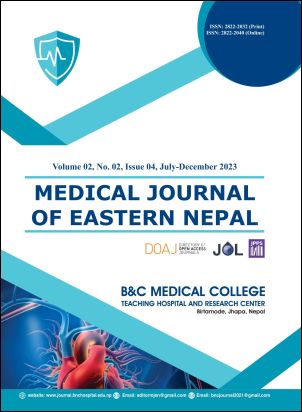Management of Splenic Injury at B&C Medical College, Teaching Hospital and Research Centre
DOI:
https://doi.org/10.3126/mjen.v2i02.60780Keywords:
Non-Operative Management (NOM), Road Traffic Accident (RTA), Length of Stay (LOS), Organ injury scale (OIS), Overwhelming post-splenectomy infection (OPSI)Abstract
Background: In all blunt abdominal injuries splenic injury relates to about 40%. Splenectomy is the preferred treatment choice for blunt splenic injury in hemodynamically unstable patients. The low-grade splenic injuries and stable patients are mostly treated by non-operative management (NOM) at today era. Consensuses have not been yet formulated about the management of high-grade splenic injuries in hemodynamically stable patients. So, this study analyzes the treatment of patients with high-grade splenic injuries in our institution.
Methods: This study includes all the patients with splenic injuries presented to our hospital during the 5 years period from 2017 to 2022. The datas regarding primary baseline at emergency, complications and mortality were collected from the patient records at medical record section. Based on splenic injury and the treatment they received, they were grouped accordingly.
Results: In a total of 38 cases of spleen injuries, the most common mode of injury was a road traffic accident (RTA) 84% followed by fall injury (10%) spontaneous rupture of the spleen and blast injury 3% each. Sixty-six per cent of the cases underwent operative management out of which 96% cases had a splenectomy and 4% cases had a splenic repair. There was 5% mortality and 95% recovery without residual morbidity.
Conclusion: Most of the cases with spleen injury were managed with a favorable outcome. The careful patient selection for non-operative management will result in higher splenic salvage with close monitoring in an intensive care unit.
Downloads
Downloads
Published
How to Cite
Issue
Section
License
Copyright (c) 2023 B & C Medical College and Teaching Hospital and Research Centre

This work is licensed under a Creative Commons Attribution 4.0 International License.
CC BY: This license allows reusers to distribute, remix, adapt, and build upon the material in any medium or format, so long as attribution is given to the creator. The license allows for commercial use.




